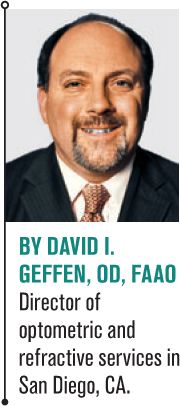The dangers of contact lenses lie with patients
In honor of Contact Lens Health Week late this summer, the Center for Disease Control (CDC) published a study titled Contact Lens Wearer Demographics and Risk Behaviors for Contact Lens-Related Eye Infections-United States–2014 which goes through the risks of contact lens wear and the costs associated with eye-related infections.

In honor of Contact Lens Health Week late this summer, the Center for Disease Control (CDC) published a study titled Contact Lens Wearer Demographics and Risk Behaviors for Contact Lens-Related Eye Infections-United States–2014 which goes through the risks of contact lens wear and the costs associated with eye-related infections.1 Upon reading this study, one might conclude that contact lenses are a dangerous modality, and we could be putting our patients’ eyesight and well-being at risk.
Related: Prevent dropout by asking the right questions
The other 99 percent
The authors found that 99 percent of contact lens wearers engage in non-compliant behavior. This should come as no surprise to a practicing doctor-if we are asking the right questions, we will discover these non-compliant behaviors in most of our patients. In past articles, I spoke about asking the right questions during our exams. It’s important to ask our contact lens patients these questions:
• How often do you fall asleep in your lenses?
• How often do you change the lens care case?
• How do you clean your case?
• How do you care for your contact lenses?
• When do you replace your lenses?
It is vital for the health of your patients to develop a script that you and your staff can ask every patient when they are in the office.
Related: Why do you choose that contact lens?
Obtaining honest answers to these questions will allow you to review proper lens hygiene and discuss the problems of not following proper procedures. Repetition is the only defense we have to help our patients avoid becoming one of the statistics in the study, having a red eye or infection, or dropping out of lens wear.
The CDC study does not differentiate where the patients purchase their lenses. While it states about 21 percent of the surveyed wearers obtained their lenses from Internet sources,1 it would be nice to see if the rates of infection and non-compliant behavior were higher in this group. I would expect that to be the case because many lens wearers purchase their lenses on the Internet to avoid paying for an eye exam and the inconvenience of going into the office.
Next: The cost of non-compliant behavior
The cost of non-compliant behavior
The study found that there are about one million visits to eye doctors for some type of keratitis or contact lens compliance problems, costing over $175 million dollars annually.1 The study does not break down these visits by contact lens-related problems vs. non-contact lens-related problems. This number does not take into account the cost of lost work time or travel expenses.
The study estimates that about 41 million contact wearer are over the age of 18. From this number, we could say that if all the keratitis events were contact lens-related, approximately 2.5 percent of all lens wearers experience some type of keratitis event. I find this to be an amazing number if we believe that 99 percent of lens wearers are performing non-compliant behavior. Most of these events are also minor in nature because they result with no vision lost, and most people return to lens wear fairly soon after treatment. Another interesting point the article does not address: how many “red eye” events do patients experience and self-treat?
The survey found abusing lenses replacement schedules as one of the most common non-compliant behaviors, and I am sure this is no surprise. Sleeping or napping in lenses is also topping the list, along with water exposure. Many people wear their lenses while swimming, and some use tap water to rinse their lenses and cases. Case replacement is another problem-patients just don’t do it frequently enough.
Related: 3 reasons why lens care is still important
Compliance keeps contact lenses safe
The CDC study concludes that we need to be more vigilant about educating our patients on compliance. This is not new information because we have been lecturing and writing about this very thing for the past 20 years. But perhaps now that the CDC has recognized this need, we may encourage more practitioners to provide the education we should have been doing for years.
Are contact lenses dangerous devices? I say no-it’s people who are dangerous. Contact lenses are safe and effective visual devices-when worn and cared for properly, they are rarely harmful. People will always find ways to abuse most any device provided. We must remain vigilant in our education of patients and provide excellent care.
Click here to check out the latest contact lens advice
References:
1. Cope JR, Collier SA, Rao MM, et al. Contact Lens Wearer Demographics and Risk Behaviors for Contact Lens-Related Eye Infections-United States, 2014. Centers for Disease Control and Prevention. Morbidity and Mortality Weekly Report. 2015 Aug 21. Available at: http://www.cdc.gov/mmwr/preview/mmwrhtml/mm6432a2.htm. Accessed 10/13/2015.